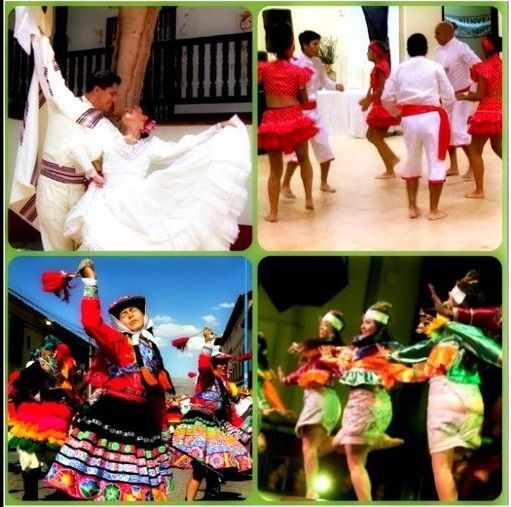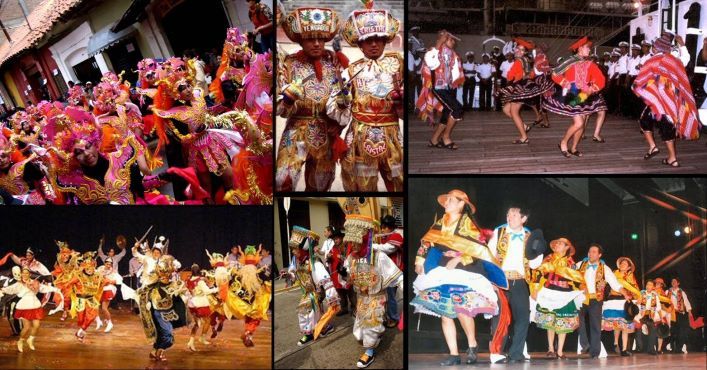Latin America is a region full of contrasts and cultural richness, where the traditions of its peoples continue to be present throughout centuries as part of its identity. Dance, that artistic expression based on movement and music, is one of the practices that generate the greatest curiosity when traveling to a certain destination; and Peru, one of the favorite countries of tourists who come to our continent, has charming typical dances.
If you want to be part of these customs, it is best to plan your trip during a traditional festival; So, as it will be difficult for it to coincide in more than two, we present you five options that will help you make a good decision.
When visiting Peru we will not only be amazed by its landscapes and its traditional gastronomy, but we will also be amazed by the color and mischief of its typical dances, which are worthy representatives of a cultural heritage that they maintain to this day.

Peruvian dances 
Peruvian dances
If you visit Perú, we recommend you to visit another impressive destinations in Cusco like the rainbow mountain tour, the humantay lake tour, or the sacred valley tour, which only takes one day. But if you are gonna to stay more days in Perú, other archaeological places you can know will be the machu picchu day tours from cusco.
The customs and traditions of Peru are part of a living culture, and its dances are expressions of this culture. Peruvian dances are characterized by the mysticism and passion that each dancer delivers on stage, in addition to their colorful clothing and joyful choreography.
These dances are neither more nor less than expressions of a living culture, full of customs and traditions that are reflected in each dance.
With dances that fuse elements and instruments of European, American and African cultures, added to the rhythm in the blood that characterizes South Americans, they result in unique typical dances.
Several of these typical dances were declared Intangible Heritage of Humanity by Unesco.
Next, the most representative folk dances of Peru:
Peruvian Dance: Marinera
The beauty of the Peruvian dance: Marinera surprises by the strength of its music, the stories its lyrics tell and the elegance with which the couples seem to dance with the wind.
The main reason why it identifies the Peruvian people is because it represents the miscegenation between indigenous, Spanish and black cultures, both in its instruments and in its choreographic part.
It is traditional from the coast of Peru, although each region throughout the country differs from the others by giving it its own characteristic.
The best time to enjoy the Peruvian dance: Marinera and all that its culture contains is during the month of January in the city of Trujillo, on the north coast of the country, when the National Marinera Contest has been held for more than 50 years.
Huayno Dance
Probably, this is the best known dance locally and internationally after the marinera, since its origins date back to the time when the Incas dominated most of the territory.
It is an Andean dance that has been modified over the centuries, adopting instruments such as the violin or the mandolin, and maintaining other traditional ones such as the quena or the charango.
The huayno dance is the dance that predominates during the festivities of the peoples of the Peruvian Andes, but being a lively and joyful musical genre, in these destinations you can find places to listen and learn to dance huayno at almost any time of the year.
It is danced in pairs, with little physical contact and, as in most ancient dances, the skirt or skirt is a fundamental garment for women to demonstrate their femininity and skills, just as men do with the hat. The constant tapping is also present and seeing it live is sure to blow your mind.
The huayno dance has some variants. Among them we can distinguish the following Huaynos:
- ANCASHINO O CHUSCADA, spread in the Sierra de Áncash and Lima.
- ARPA OR CHIMAYCHE, spread between the Sierra de Áncash and Lima.
- CENTRAL OR HUANCAÍNO, spread between the Sierra de Junín and Huancavelica.
- SUREÑO OR PUNEÑO, spread between the mountains of Puno and Tacna.
- PANDILLERO OR MESTIXO, broadcast in Puno.
- PASACALLE OR CACHARPARI AYMARA, spread in the Aymara highlands of Puno.
Regarding the dance itself, we can say that we are going to find several versions depending on the region where it is performed, but it will always maintain the characteristic of having a trot or stomping as a basic step and of being a mixed collective dance of a row, taken hand in hand, making various figures (snail, circle or snake) and their dancers singing while dancing.
Whatever your version, the message to express is the same, a story of infatuation and courtship towards the lady with a share of suffering and disappointment over the loss of her.
With respect to clothing, colorful and cheerful costumes are used, made of woven and embroidered llama wool, as are the typical costumes of the Peruvian Andes.
Scissors dance
This particular dance, which can seem quite funny and strange due to the mixture of instruments, rhythms and dance steps, is originally from the Ayacucho region and is performed with violin and harp.
In front of the musicians the dancers dance using their feet more than anything else, and giving between touching scissors that they carry in their hands. They are dressed in full dress, since historically this was the traditional dance “tusuk laykas”, as the priests, sorcerers and healers of the pre-Hispanic era were called.
Its choreography is so elaborate, that during a time the settlers called it the devil’s dance, stating that these abilities were only obtained through a pact with the dark world.
It is given this name since the dancers or rather DANZAQ, have in their right hand 2 metal blades similar to a scissors which they shake.
The dance is posed in groups (made up of the dancer, a violinist and a harpist) where each represents a specific people.
The dancers face each other and there begins a kind of challenge where they seek to overcome each other in the face of the risks of the steps they perform, and the winner will be the one who expresses superior physical dexterity, their choreography has the greatest difficulty and their interpretation is the most significant.
At present it is Intangible Cultural Heritage and it is still danced in the different festivals and ceremonies of the area, especially in agricultural and religious celebrations. If you want to enjoy this beautiful show, the Christmas season is a good opportunity to do so.
Afro-Peruvian Dance
The Afro-Peruvian dance is a representative dance of the Peruvian coast, mostly performed by Afro-Peruvian descendants.
Initially her music was based on leather drums and maracas, which over the years was changed to the cajon and donkey jaw, adding guitar and singing.
Regarding its origin, it is ensured that it was created in San Luis, Cañete, Lima and the El Carmen District, where its authors settled; the Africans brought to Peru during the 17th century by the Spanish conquerors.
The cold climate of the mountains was a challenge for Africans. In the lyrics of El Festejo the customs, joys, sorrows and sufferings of the black race of that time are narrated.
This Afro-Peruvian dance is a festive rhythm, very representative of the Peruvian black miscegenation, which to this day remains in force in Lima and Ica.
It is danced both in popular parties and in family gatherings, where the dancers are in an act of continuous infatuation, the gestures, the movements of the arms and hips, the flying of the skirts, are elements that differentiate El Festejo from other dances. .
With regard to clothing, there are those who use that of black slaves, while others are inclined towards 19th century costumes.
Nowadays the Afro-Peruvian dance is danced a lot in Peru, wanting to express the Afro-Peruvian pride that society feels.










